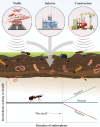Monitoring soil fauna with ecoacoustics
- PMID: 39226929
- PMCID: PMC11371423
- DOI: 10.1098/rspb.2024.1595
Monitoring soil fauna with ecoacoustics
Abstract
Ecoacoustics-or acoustic ecology-aids in monitoring elusive and protected species in several ecological contexts. For example, passive acoustic monitoring (PAM), which involves autonomous acoustic sensors, is widely used to detect various taxonomic groups in terrestrial and aquatic ecosystems, from birds and bats to fish and cetaceans. Here, we illustrate the potential of ecoacoustics to monitor soil biodiversity (specifically fauna)-a crucial endeavour given that 59% of species live in soil yet 75% of soils are affected by degradation. We describe the sources of sound in the soil (e.g. biological, geological and anthropogenic) and the ability of acoustic technology to detect and differentiate between these sounds, highlighting opportunities and current gaps in knowledge. We also propose a roadmap for the future development of optimized hardware, analytical pipelines and experimental approaches. Soil ecoacoustics is an emerging field with considerable potential to improve soil biodiversity monitoring and 'soil health' diagnostics. Indeed, early studies suggest soil ecoacoustics can be successfully applied in various ecosystems (e.g. grasslands, temperate, tropical and arid forests) and land uses (e.g. agriculture, viticulture, natural and restored ecosystems). Given the low cost, minimal intrusiveness, and effectiveness in supporting soil biodiversity assessments and biosecurity risks, we advocate for the advancement of soil ecoacoustics for future land management applications.
Keywords: bioacoustics; biomonitoring; ecoacoustics; soil biodiversity; soil health.
Conflict of interest statement
We declare we have no competing interests.
Figures




References
-
- Waltham NJ, et al. . 2020. UN decade on ecosystem restoration 2021–2030—what chance for success in restoring coastal ecosystems? Front. Mar. Sci. 7 . (10.3389/fmars.2020.00071) - DOI
-
- Neemisha K. 2020. Role of soil organisms in maintaining soil health, ecosystem functioning, and sustaining agricultural production. Soil Health 313–335. (10.1007/978-3-030-44364-1_17) - DOI
Publication types
MeSH terms
Substances
Grants and funding
LinkOut - more resources
Full Text Sources
Miscellaneous
